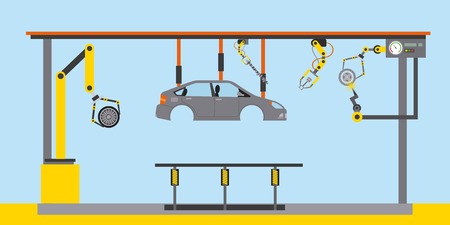1. Introduction
Self-driving cars, also known as autonomous vehicles, have transformed from science fiction dreams to real-world innovations. These vehicles use advanced sensors, artificial intelligence (AI), and machine learning to navigate roads with little to no human intervention. The development of self-driving technology marks one of the most significant advancements in transportation history.
Why Are Self-Driving Cars Important?
The impact of autonomous vehicles goes beyond convenience. They have the potential to improve road safety, reduce traffic congestion, and optimize fuel efficiency. By eliminating human error, which is one of the leading causes of accidents, self-driving cars aim to create safer roads for everyone.
The Purpose of This Discussion
This article explores the evolution of self-driving cars by examining their past, present, and future. From early innovations to modern-day developments and future possibilities, we will dive into how autonomous technology has changed over time and what it means for the future of transportation.
2. The Early Days of Autonomous Vehicles
A look back at the origins of self-driving technology, from early experiments to foundational breakthroughs.
Early Experiments in Autonomous Vehicles
The idea of self-driving cars has been around for decades. Engineers and researchers have long dreamed of vehicles that could navigate without human intervention. Some of the earliest attempts date back to the 1920s and 1930s, with radio-controlled cars being tested on closed tracks.
Radar and Computer Vision in the 1950s and 1960s
In the mid-20th century, researchers started experimenting with radar and early computer vision to help vehicles detect their surroundings. These were the building blocks of modern autonomous vehicle (AV) technology. Vehicles equipped with primitive sensors were tested in controlled environments, but the technology was still in its infancy.
Breakthroughs in the 1980s and 1990s
The autonomous vehicle field saw significant progress in the 1980s and 1990s. Several research institutions developed experimental AVs that could navigate highways. One of the most famous projects was the NavLab series developed by Carnegie Mellon University, which showcased early self-driving capabilities.
Notable Early Autonomous Vehicle Projects
| Project | Year | Key Innovations |
|---|---|---|
| Radio-Controlled Cars | 1920s-1930s | Remotely operated vehicles tested on tracks |
| Stanford Cart | 1960s | Early application of computer vision to navigation |
| NavLab (Carnegie Mellon) | 1980s-1990s | One of the first self-driving car prototypes |
| Mercedes-Benz Eureka Project | 1990s | Demonstrated lane-keeping and highway autonomy |
The Foundation for Modern Self-Driving Cars
Although these early projects did not result in fully autonomous vehicles like todays models, they laid the groundwork for major advancements. Many of the sensor technologies, algorithms, and computing techniques developed in these experiments are still fundamental to modern self-driving systems.

3. Three, Current Advancements and Challenges
Self-driving cars have come a long way in recent years, with major advancements in artificial intelligence, sensor technology, legal regulations, and road safety. However, challenges still remain as companies and governments work towards fully autonomous vehicles. Below, we explore the latest developments and obstacles in this evolving industry.
Artificial Intelligence and Machine Learning
AI plays a crucial role in self-driving cars, allowing vehicles to process massive amounts of data and make real-time decisions. Machine learning algorithms train these systems to recognize objects, predict the movements of pedestrians, and navigate complex environments. However, AI still faces limitations in unpredictable situations, such as sudden road closures or extreme weather conditions.
Sensor Technology: LiDAR, Cameras, and Radar
Self-driving cars rely on multiple sensors to perceive their environment. These technologies work together to create a 360-degree view of the surroundings:
| Sensor Type | Function | Strengths | Limitations |
|---|---|---|---|
| LiDAR | Uses laser beams to create a 3D map | Highly accurate in object detection | Expensive and struggles in bad weather |
| Cameras | Captures images and detects lane markings and traffic signs | Good for reading signs and signals | Can be affected by poor lighting conditions |
| Radar | Measures distance and speed of objects | Works well in all weather | Less precise in identifying small objects |
Legal Regulations and Government Policies
As self-driving technology advances, governments are creating new legal frameworks to ensure safety. The U.S. has different regulations depending on the state, with some places allowing autonomous vehicle testing on public roads. At the federal level, policies continue to evolve to establish guidelines for manufacturers and operators, but uncertainties remain about liability in case of accidents.
Road Safety and Public Acceptance
Safety is one of the most important factors in the development of self-driving cars. While autonomous vehicles aim to reduce accidents caused by human error, there have been incidents that raise concerns. Public trust is also a hurdle, as many people are still hesitant to ride in a fully autonomous vehicle. Companies are working to build confidence through extensive testing and transparency about safety measures.
4. Four, The Future of Autonomous Vehicles
Predictions for the Evolution of Self-Driving Cars
Self-driving car technology is advancing rapidly, and the future holds exciting possibilities. We can expect improvements in artificial intelligence, sensor technology, and vehicle-to-everything (V2X) communication. These innovations will bring self-driving cars closer to full autonomy, enhancing their efficiency and safety on the roads.
Potential Impact on Society
As autonomous vehicles become more common, they will significantly impact various aspects of society. Changes in transportation, economy, and daily life will shape how people interact with cars and urban environments. Here are some potential effects:
| Area | Potential Impact |
|---|---|
| Transportation | Reduced traffic congestion, improved ride-sharing, and fewer accidents. |
| Economy | Job shifts in transportation industries, increased demand for software engineers, and changes in car ownership models. |
| Environment | Lower carbon emissions due to efficient driving patterns and increased use of electric self-driving cars. |
| Urban Planning | Redesign of cities with fewer parking lots and better road networks for self-driving systems. |
The Road Ahead for Full Autonomy
Achieving full autonomy still presents challenges. Regulatory frameworks, public trust, and ethical concerns must be addressed before self-driving cars can operate without human intervention. Automakers and tech companies continue to improve Level 4 and Level 5 automation, bringing us closer to a future where autonomous vehicles dominate the roads.
Key Challenges to Overcome
- Legal and regulatory approval for driverless cars.
- Ensuring AI reliability in complex real-world scenarios.
- Public confidence in autonomous vehicle safety.
- Cybersecurity measures to protect self-driving systems.
Final Thoughts on the Future
While fully autonomous vehicles are not yet a daily reality, progress is being made at an incredible pace. As technology advances, self-driving cars will improve safety and efficiency, transforming the way we travel in the years to come.
5. Conclusion
Self-driving cars have come a long way, from early experiments with automation to the sophisticated AI-driven systems we see today. The evolution of this technology has been driven by advancements in artificial intelligence, sensor technology, and computing power.
Here’s a quick summary of how self-driving cars have evolved over time:
| Period | Key Developments |
|---|---|
| 1980s-1990s | Early research and development, basic automation in vehicles |
| 2000s | Advancements in AI and machine learning, DARPA Grand Challenge driving innovation |
| 2010s | Big investments from tech companies, real-world testing of autonomous cars |
| 2020s & Beyond | Improved safety features, regulatory developments, commercial adoption of self-driving technology |
While self-driving cars are not yet fully integrated into everyday life, they continue to develop at a rapid pace. Companies are working on improving safety, reliability, and public acceptance. Challenges such as regulations and ethical considerations still need to be addressed, but the future looks promising.
As technology advances, self-driving cars have the potential to make transportation safer, reduce traffic congestion, and increase mobility for people who cannot drive. Though there are still hurdles to overcome, the journey towards fully autonomous vehicles is well underway. The next decade will likely bring even more exciting developments in this field.

